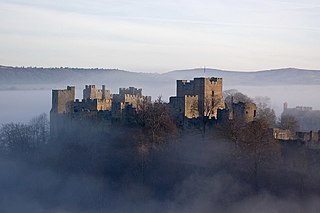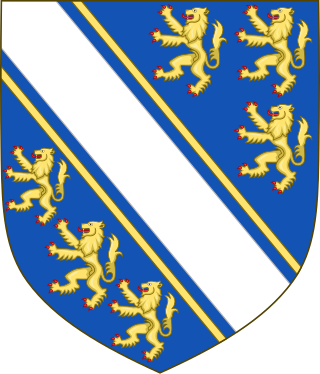Related Research Articles

The Lord High Constable of England is the seventh of the Great Officers of State, ranking beneath the Lord Great Chamberlain and above the Earl Marshal. This office is now called out of abeyance only for coronations. The Lord High Constable was originally the commander of the royal armies and the Master of the Horse. He was also, in conjunction with the Earl Marshal, president of the court of chivalry or court of honour. In feudal times, martial law was administered in the court of the Lord High Constable.

Miles FitzWalter of Gloucester, 1st Earl of Hereford was a great magnate based in the west of England. He was hereditary Constable of England and Sheriff of Gloucestershire.
Hugh de Morville of Appleby in Westmorland, England, hereditary Constable of Scotland, was a Norman knight who made his fortune in the service of David FitzMalcolm (d.1153), Prince of the Cumbrians, later King of Scotland.

Henry FitzMiles, Baron Abergavenny was a Norman baron and a Marcher Lord in the Welsh Marches.
Walter of Gloucester was an early Anglo-Norman official of the King of England during the early years of the Norman conquest of the South Welsh Marches. He was a sheriff of Gloucester and also a Constable under Henry I.
Bertha of Hereford, also known as Bertha de Pitres, was the daughter of Miles de Gloucester, 1st Earl of Hereford, and a wealthy heiress, Sibyl de Neufmarché. She was the wife of William de Braose, 3rd Lord of Bramber to whom she brought many castles and Lordships, such as Brecknock, and Abergavenny.

William de Chesney was an Anglo-Norman magnate during the reign of King Stephen of England and King Henry II of England. Chesney was part of a large family; one of his brothers became Bishop of Lincoln and another Abbot of Evesham Abbey. Stephen may have named him Sheriff of Oxfordshire. Besides his administrative offices, Chesney controlled a number of royal castles, and served Stephen during some of the king's English military campaigns. Chesney's heir was his niece, Matilda, who married Henry fitzGerold.
Walter de Beauchamp was a medieval nobleman and Sheriff of Worcestershire. Married to the daughter of one of his predecessors as sheriff, nothing is known for sure of his background before he appears as a witness to royal charters between 1108 and 1111. Beauchamp also inherited offices in the royal household from his father-in-law, and also appears to have been a royal forester. He and another nobleman divided some of the lands of his father-in-law, but disagreements about the division lasted until the 12th century between the two families. He died between 1130 and 1133, and one of his descendants later became Earl of Warwick.
Sibyl de Neufmarché, Countess of Hereford, suo jure Lady of Brecknock, was a Cambro-Norman noblewoman, heiress to one of the most substantial fiefs in the Welsh Marches. The great-granddaughter of Gruffydd ap Llywelyn, king of Wales, Sibyl was also connected to the nobility of England and Normandy. Sibyl inherited the titles and lands of her father, Bernard de Neufmarché, Lord of Brecon, after her mother, Nest ferch Osbern, had declared her brother Mahel to have been illegitimate. Most of these estates passed to Sibyl's husband, Miles de Gloucester, 1st Earl of Hereford, as her dowry. Their marriage had been arranged personally by King Henry I of England in the spring of 1121. Sibyl, with her extensive lands, was central to the King's plans of consolidating Anglo-Norman power in south-east Wales by the merging of her estates with those of Miles, his loyal subject on whom he relied to implement Crown policy.

Pain fitzJohn was an Anglo-Norman nobleman and administrator, one of King Henry I of England's "new men", who owed their positions and wealth to the king.
Brian fitz Count was descended from the Breton ducal house, and became an Anglo-Norman noble, holding the lordships of Wallingford and Abergavenny. He was a loyal adherent of Henry I, King of England, and a staunch supporter of his daughter, the Empress Matilda, during the Anarchy (1135–1153).
William de Chesney was a medieval Anglo-Norman nobleman and sheriff. The son of a landholder in Norfolk, William inherited after the death of his two elder brothers. He was the founder of Sibton Abbey, as well as a benefactor of other monasteries in England. In 1157, Chesney acquired the honour of Blythburgh, and was sheriff of Norfolk and Suffolk during the 1150s and 1160s. On Chesney's death in 1174, he left three unmarried daughters as his heirs.
Geoffrey Talbot was a medieval Anglo-Norman nobleman during the civil war of King Stephen of England's reign. His landholdings around Swanscombe are considered to possibly constitute a feudal barony. Although he was at Stephen's court in early 1136, by 1138 Talbot was supporting Stephen's rival, Matilda. After escaping capture twice, Talbot was captured by partisans of Stephen but was released. In 1139 and 1140, Talbot was engaged in military operations around Hereford, which included fortifying Hereford Cathedral in an attempt to take Hereford Castle.

Walter de Lacy was a Norman nobleman who went to England after the Norman Conquest of England in 1066. He received lands in Herefordshire and Shropshire, and served King William I of England by leading military forces during 1075. He died in 1085 and one son inherited his lands. Another son became an abbot.
Roger de Pitres, a Norman, was the Sheriff of Gloucester under William the Conqueror and constable of Gloucester Castle.

The de Bohun then Bohun family is an English noble family of Norman origin that played a prominent role in English political and military history during the Late Middle Ages. The swan used by the family and their descendants as a heraldic badge came to be called the Bohun swan.
Adam de Port was an Anglo-Norman nobleman and Baron of Kington.
Robert fitz Walter, lord of Horsham was an English nobleman who served as the Sheriff of Norfolk and Suffolk.

Durand of Gloucester was Sheriff of Gloucestershire in 1086 and was one of the tenants-in-chief of King William the Conqueror in Gloucestershire and elsewhere, with a total of 63 holding listed in the Domesday Book of 1086.
References
- Cokayne, George E (2000), The Complete Peerage of England, Scotland, Ireland, Great Britain and the United Kingdom, Extant, Extinct or Dormant, vol. I (new, 13 volumes in 14 (1910-1959; reprint in 6 volumes ed.), Gloucester, U.K.: Alan Sutton Publishing, pp. 20, 21
- Keats-Rohan, Katharine S. B. (2002), Domesday Descendants - A Prosopography of Persons Occurring in English Documents 1066-1166 - II: Pipe Rolls to Cartae Baronum, Domesday Descendants (1st ed.), Woodbridge, Suffolk: The Boydell Press, p. 512, ISBN 0-85115-863-3